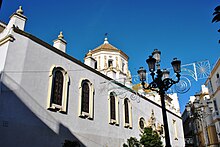- For other places with the same name, see Cadiz (disambiguation).
Cadiz is the capital of the Cadiz Province in the Andalucia. Cádiz is, in most respects, a typically Andalusian city with a wealth of attractive vistas and well-preserved historical landmarks.
Understand
editCádiz sits on a narrow slice of land surrounded by the sea. The older part of Cadiz, within the remnants of the city walls, is commonly referred to as the Old Town. It is characterised by the antiquity of its various quarters, among them El Pópulo, La Viña, and Santa María, which present a marked contrast to the newer areas of town. While the Old City's street plan consists of narrow winding alleys connecting large plazas, newer areas of Cadiz typically have wide avenues and more modern buildings. In addition, the city is dotted with numerous parks where exotic plants flourish, including giant trees supposedly brought to Spain by Columbus from the New World.
In 2019, the city had about 117,000 residents.
History
editCádiz is the oldest continuously inhabited city in the Iberian Peninsula and one of the oldest in all southwestern Europe. Traditionally, its founding is dated to 1104 BC.
The city was founded by Phoenicians from Tyre, who called it Gadir. Over the years the city changed hands (and names!) many times. It was inhabited by the Romans, destroyed by the Visigoths, rebuilt by the Byzantines, and occupied by the Moors until they were removed in 1262 AD by the Spanish.
Christopher Columbus sailed from Cádiz on his second and fourth voyages, and the city later became the home port of the Spanish treasure fleet.
In the 18th century, it became one of Spain's greatest and most cosmopolitan cities and home to trading communities from many countries. Many of today's historic buildings in the Old City date from this era.
The city has undergone much reconstruction. Many monuments, cathedrals, and landmarks have been cleaned and restored, adding to the charm of this ancient city.
Climate
editCádiz has a Mediterranean climate with very mild winters and warm to hot summers. Cádiz one of the sunniest cities in Europe with more than above 3000 hours of sun a year. Although summer nights are tropical in nature, daytime temperatures are comparatively subdued compared to nearby inland areas such as Jerez and the very hot far inland areas in Andalusia.
Get in
edit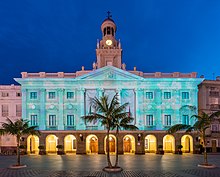
By plane
editThe closest airport is Jerez de la Frontera, about 30 minutes by car or taxi (fixed price €46), 1 hour by direct bus, though there are few buses and the schedules do not fit most flights. Trains to Jerez Aeropuerto are usually fit for national flights. There are several daily flights to Madrid and Barcelona (Iberia, Vueling). Ryanair flies daily to London Stansted and Frankfurt Hahn. Other operators fly scheduled, charter, or seasonal flights. The nearest major airports are in Sevilla (1 hour by car, 2 hours by bus or train) and Malaga (2-3 hours by car or bus).
By carpooling
editIn Southern Spain (Andalusia) you usually get a better price using Blablacar than travelling by train or intercity bus.
Take care that the ride goes actually to Cádiz. Blablarcar also shows rides that only go to El Puerto de Santa Maria, Puerto Real or somewhere in the Province of Cádiz making an additional bus ride necessary.
By bus
editBy train
edit- 2 Cádiz railway station (Estación de Cádiz), Plaza de Sevilla, 1.
Frequent trains run to Jerez and about hourly to Seville. A very convenient way to come in from Madrid is with the Talgo train that runs twice a day covering the distance in about 5 hours.
From Jerez to Cadiz fares are around €7 (Dec 2024) - see train timetable here .
Trains from Seville are around €16 for a single and €20 for a return. If you get a return you have to book your seat reservation for the way back upon arrival at the station, otherwise you'll be expected to pay the full fare!
One or two intercity trains travel from Cadiz directly to Spain's east coast, no changes required. The journey from Valencia takes around 8h30, passes through a wide variety of landscapes and at a lower price than a high-speed connection via Madrid.
By car
editFrom Madrid, Cordoba and Seville you can use the A4, from Barcelona N340. A taxi ride from Jerez de la Frontera to Cadiz costs about €50.
By boat
editCádiz is one of two ports in mainland Spain with ferry connections to the Canary Islands. Transmediterranea runs one weekly sailing to and from Gran Canaria, Tenerife and Lanzarote (36-40 hr). Unfortunately tariffs are relatively high, particularly for non-residents: around €400 for a cabin or €140 for a recliner, one-way (July 2023). Ferries are modern and comfortable, resembling mini cruise ships.
Commuter ferries run several times per day from Rota and Puerto de Santa Maria, operated by CMTBC. Additionally, Cádiz is a popular destination for cruise ships.
All ferries arrive at the harbour directly adjacent to the old town.
Cruise ships occasionally stop in Cadiz; in particular Cunard line uses Cadiz as a port.
Get around
editSan Fernando, El Puerto de Santa Maria, Conil, Vejer, Medina Sidonia, Arcos de la Frontera, Jerez
With the rechargable green travel card you can use all means of public transport (regional trains, city and regional buses) for a lower price. The card can be bought in tobacco shops for €1.50 and must be charged with at least €5 (Nov 2024). There is another travel card issued by the city bus operator, but you can only use the city buses with it.
There are 5 bus routes which tour the town and all start and finish at old and new towns, going in a loop. It's €1.10 per ride. The most central is the number 1 and number 2, which goes right from the old town towards the stadium at the southern end of new town.
The number 7 follows the coastline and goes between the two beaches.
See
edit
- The old town is characterized by narrow streets connecting squares (plazas), bordered by the sea and by the city walls. Most of the landmark buildings are in the plazas.
- Archeological remains can be found all around the old town. The massive stone walls and forts surrounding the old town were built after the British naval attack and sacking in 1596 (the "singeing of the Spanish King's beard", in the words of the British commander, Sir Francis Drake), and the forts of San Sebastian and Santa Catalina (and occasionally Baluarte de la Concepción) are open to the public.
- The church Oratorio de San Felipe Neri, where the first Spanish Constitution was signed, has plenty of marble and bronze plates to honour the representatives from mainland Spain and colonial territories, ranging from Philippines Islands to Central and South America.
- 1 The Museum of Cádiz, 5, Plaza de Mina. Its exhibits are interesting, specially two Phoenician stone sarcophagi. The remains of the Roman theatre, just behind the Old Cathedral, are also worth a visit. It has many objects from Cádiz's 3000-year history and works by artists such as Peter Paul Rubens.
- The Central Market is well worth a visit in the morning, especially the fish section.
- A modern monument of Cádiz are the huge pylons of the powerline crossing the bay of Cádiz. These 150-metre-high pylons are lattice towers with cylindrical cross section.
Plazas and their landmark buildings
editThe old town of Cádiz is one of the most densely populated urban areas in Europe, and is packed with narrow streets. The old town benefits, though, from several striking plazas, which are enjoyed by citizens and tourists alike. These are the Plaza de Mina, Plaza San Antonio, Plaza de Candelaria, Plaza de San Juan de Dios, and Plaza de España.
Plaza de Mina
editLocated in the heart of the old town, Plaza de Mina was developed in the first half of the 19th century. The land had been the orchard of the convent of San Francisco, and was converted into a plaza in 1838. It was then redeveloped again in 1897, and has remained virtually unchanged since that time. The houses which face the plaza, many of which can be classified as neo-classical architecture or built in the style of Isabelline Gothic, were built for the Cádiz bourgeoisie.
The Plaza de la Catedral houses the Cathedral and the Baroque church of Santiago, built in 1635.
Plaza de San Francisco and San Francisco Church and Convent
editPlaza San Antonio
edit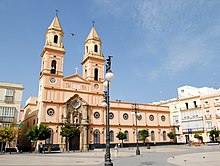
In the 19th century, Plaza San Antonio was considered to be Cádiz's main square. The square is surrounded by a number of mansions built in neo-classical architecture or Isabelline Gothic style, once occupied by the Cádiz upper classes. San Antonio church, built in 1669, is also in the plaza.
The plaza was built in the 18th century, and the Spanish Constitution of 1812 was proclaimed here.
Plaza de Candelaria
editThe Plaza de Candelaria is named after the Candelaria convent, situated in the square until it was demolished in 1873 under the First Spanish Republic, when its grounds were redeveloped as a plaza. The plaza is notable for a statue in its centre of Emilio Castelar, president of the first Spanish republic, who was born in a house facing the square. A plaque situated on another house, states that Bernardo O'Higgins, an Irish-Chilean adventurer and dictator of Chile, also lived in the square.
Plaza de la Catedral and the Cathedral
edit
One of Cádiz's most famous landmarks is its cathedral. Work on this cathedral started in 1722 and was supervised by the architect Vicente Acero, who had also built the Granada Cathedral. Acero resigned from the project and was succeeded by several other architects. As a result, this largely Baroque-style cathedral was built over a period of 116 years, and, due to this drawn-out period of construction, the cathedral underwent several major changes to its original design. Though the cathedral was intended to be a baroque edifice with some rococo elements, it was completed in the Neoclassical architecture|neoclassical style. Climb to the top of the North Tower for a nice view of the entire city.
Plaza de San Juan de Dios and the Old Town Hall
edit
Construction of this plaza began in the 15th century on lands reclaimed from the sea. With the demolition of the city walls in 1906 the plaza increased in size and a statue of the Cádiz politician Segismundo Moret was unveiled. Overlooking the plaza, the Ayuntamiento is the town hall of Cádiz's Old City.
Plaza de España and the monument to the Constitution of 1812
editPlaza de Falla and the Gran Teatro Falla (Falla Grand Theater)
editThe theater was built between 1884 and 1905 over the remains of the previous Gran Teatro. The outside was covered in red bricks and is of a neo-Mudéjar or Moorish Revival style.
The Constitution of 1812 Bridge, also known as La Pepa Bridge, is a new bridge across the Bay of Cádiz, linking Cádiz with the town of Puerto Real.
This is one of the highest bridges in Europe, with 5 km in total length. It is the third access to the city, along with the San Fernando road and the Carranza bridge.
Tavira tower
editThis tower was located on a high point in the city, near the Central Market (Mercado de Abastos), 45 m above sea level. It was chosen by the Navy as their official lookout in 1787. It is the tallest of the towers which still dot the Cádiz skyline. There is a camera obscura, a room that uses the principle of the pinhole camera and a specially prepared convex lens to project panoramic views of the Old City onto a concave disc. One of the towers that was used by merchants to watch out for their ships returning home from the Americas, it provides a birds-eye view of the old part of town.
Admiral's House
edit
The Casa del Almirante is a palatial house, adjacent to the Plaza San Martín in the Barrio del Pópulo, which was constructed in 1690 with the proceeds of the lucrative trade with the Americas. The exterior is sheathed in exquisite red and white Genoan marble. The colonnaded portico, the grand staircase under the cupola, and the hall on the main floor are architectural features of great nobility and beauty.
Old customs house
edit
Situated within the confines of the walls which protect the flank of the port of Cádiz are three identical adjacent buildings: the Customs House, the House of Hiring and the Consulate. Of the three, the former had been erected first, built in a sober neo-classical style and of ample and balanced proportions. The works began in 1765.
Palacio de Congresos
editCádiz's refurbished tobacco factory offers international conference and trade-show facilities.
Roman theatre
editThe Roman theatre was discovered in 1980, in the El Pópulo district, after a fire had destroyed some old warehouses, revealing a layer of construction that was judged to be the foundations of some medieval buildings; the foundations of these buildings had been built, in turn, upon much more ancient stones, hand-hewn limestone of a Roman character. Systematic excavations have revealed a largely intact Roman theatre.
The theatre, constructed during the 1st century BC, is the second-largest Roman theatre in the world, surpassed only by the theatre of Pompeii.
Pylons of Cádiz
editThe Pylons of Cádiz are electricity pylons of unusual design, one on either side of the Bay of Cádiz, used to support huge electric-power cables. The pylons are 158 m high.
City walls and fortifications
editLas Puertas de Tierra originated in the 16th century. Once consisting of several layers of walls, only one of these remain today. By the 20th century it was necessary to remodel the entrance to the Old City to accommodate modern traffic. Today, the two side-by-side arches cut into the wall serve as one of the primary entrances to the city.
El Arco de los Blancos is the gate to the Populo district, built around 1300. It was the principal gate to the medieval town. The gate is named after the family of Felipe Blanco who built a chapel (now disappeared) above the gate.
El Arco de la Rosa ("Rose Arch") is a gate carved into the medieval walls next to the cathedral. It is named after captain Gaspar de la Rosa, who lived in the city during the 18th century. The gate was renovated in 1973.
The Baluarte de la Candelaria (fortress or stronghold of Candlemas) is a military fortification. Taking advantage of a natural elevation of land, it was constructed in 1672. Protected by a seaward-facing wall that had previously served as a seawall, Candelaria's cannons were in a position to command the channels approaching the port of Cádiz. It is now used as a cultural venue.
The Castle of San Sebastián is also a military fortification and is situated at the end of a road leading out from the Caleta beach. It was built in 1706.
The Castle of Santa Catalina is also a military fortification at the end of the Caleta beach. It was built in 1598 following the English sacking of Cádiz two years earlier. It is used for exhibitions and concerts.
Do
edit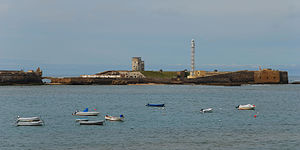
- Admire the sunset at Playa de la Caleta at the northern end of the old town. The main beaches (Santa Maria del Mar, Victoria, and Cortadura) start at the edge of the old town, continue all along the new town, and on alongside the road to San Fernando. In total some 10 km of the widest, cleanest beaches you will find in Europe, with safe bathing from around May to October. The summer heat is usually tempered by an Atlantic breeze, although on days when the Levante blows beware of flying sand.
- Victoria Beach is a short bus ride (number 7 or number 2) away from the old town and is beautiful with clean water and lots of activities including beach football and volleyball, surfing and kite flying all available.
- Football: Cádiz CF were relegated in 2024 and play soccer in Segunda División, the second tier. Their home ground is Nuevo Mirandilla (capacity 20,700) south end of city island.
- Carnaval in Cadiz is one of the oldest and best in Spain, often cited as the third biggest Carnaval celebration in the world. Usually in February, the weekend before Ash Wednesday is consistently the loudest and most eventful so be sure to check the calendar. Singing, dancing and costumes run for the whole week. Informal groups (chirigotas, cuartetos, coros, comparsas and romanceros) sing at the old town streets, usually with strong critics on local, national and international politics, the jet set, and just about anything/anybody, up to the Royal Family. Make your travel plans early as most accommodation gets booked months in advance and be prepared to spend almost double for the week of Carnaval. One way to experience Carnaval on the dime, and perhaps the preferred way of Andalusian locals, is to board an afternoon train heading to Cadiz, spend the night singing and dancing, then catch the first train back in the morning. Expect singing, dancing, costumes and drinking on all trains. Sleeping on the public beach is also another popular option, though be sure to bring a blanket or sleeping bag, both of which can be stored in lockers at the train station; expect company and use common sense.
- Semana Santa (Easter or Holy Week) is less formal than in Sevilla, and probably more authentic and emotive an experience for that.
Buy
editStandard souvenirs can be found at several shops in Calle Pelota, Calle Compañía, Calle San Francisco and Plaza de Candelaria.
Eat
edit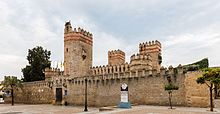
In Cadiz you will find some of the best and freshest fish and shellfish in the world. They are best eaten as simply cooked as possible: plain boiled shellfish (in varying sizes from tiny prawns up to lobsters), grilled or baked whole fish such as lubina (bass) or dorada (bream), or deep fried with a light flour coating (especially puntillitas (baby squid) and boquerones (anchovies)).
To eat not too expensive fish and shellfish, you can look at Calle Zorrilla (several tapas bars and street vendors) or Calle de la Palma (several restaurants with open air terraces).
Budget
editMany budget eateries are in the 1 Mercado Central de Abastos.
- 2 Casa Hidalgo, Plaza de la Catedral, 8. A great bakery that specializes in Galician empanadas (try the Empanada de Atún - sounds bad, tastes delicious), but also have great pastries of all kinds. Locals flock to this local institution for the scrumptious ensaimadas, salvavidas, and brazos de gitano.
- 3 La Taperia De La Abuela Maria, C. San Juan, 38.
- 4 Restaurante Menoc Donald, C. Sagasta, 2.
Mid-range
edit- 5 Balandro, Alameda de Apodaca, 22, ☏ +34 956 22 09 92. open 13:00 - 16:00 and 20:00 - 24:00. Modern bar with good food typical from Cadiz. Ypu can get tapas at the bar and sit down meals. The quantities are generous. It's located on the coastline and as such, they seem to get the pick of the fish that comes in every day. €20-30.
- 6 El Merodio, C/Libertad 4. €12-22.
- 7 Cumbres Mayore (Calle Zorilla). Tapas with a focus on the famous Iberican hams and meats. €15-25.
Splurge
edit- El Faro, Calle San Felix 15. The best place in town. But even here food can be not very expensive, if you stand at the bar and eat only tapas.
Drink
editFino, a (16% alcohol) bone dry sherry (or Jerez), or manzanilla, a similar wine from Sanlucar de Barrameda, is the perfect aperitif with olives or a prawn or two. Drinking more than a couple of glasses may spoil your focus on the rest of the meal. The best local white wine (and one of the most popular in Spain) is Barbadillo, made from the same grape but considerably lighter (11%). You should visit Taberna de la Manzanilla, one of the oldest bars and wine merchants in town, selling nothing but sherry wines. No tapas but just 2 complimentary olives per glass of wine. Forget about local red wine. Quality is far below other Spanish areas producing red wines, such as Rioja or Ribera de Duero.
- Bar Cuba, Calle de Murquia. Owner Richard is a bit of a local legend after naming his bar after his wife's nationality. You'll find a good deal of cocktails and beers for around €1.
- Woodstock. A good mix of locals and Erasmus students in here. They offer deals midweek and a bar crawl runs from 23:00 on Tuesday and Wednesday, although the turnout isn't always fantastic
- O'Connels. Wherever you go, there's always an Irish bar and Cadiz is no exception. Will show most of the major UK soccer games if you fancy catching it, although beer here is pricier as it's imported.
- Bar Nahu. The main haunt for internationals during the weekdays and weekends. Closes late (around 15:00) and is exceptionally cheap. You'll get lots of English speakers in here, especially around the end of September/start of October as that's when the Erasmus scheme arrives and people like to get to know people
- SPAM! Club. This is usually where the Nahu frequenters end up after Nahu. More expensive but open till 07:00.
- Imaginarium. Only open on Thursday, Friday, Saturday. It's closer to the new town, but you'll find some famous acts going on if you're lucky and is always jam packed.
Sleep
editBudget
editCalle Marques de Cadiz has several budget options, doubles at about €35 with shared bath.
- Cadiz Inn Backpackers, Hostel, Calle Botica 2, ☏ +34 956 26 23 09, booking@cadizbackpackers.es. Check-in: 13:00, check-out: 11:00. Cheap, clean and welcoming hostel with international staff, located in the old town, within easy walking distance of the bus and train station. Dorms from €13, rooms from €20.
- Casa Caracol. Inexpensive and quite relaxed hostel in the old part, very close to the train station and with hammocks on the rooftop.
- Hostal La Cantarera. A hostel with clean, luxurious rooms and friendly management, in the old town.
Mid-range
edit- Hotel Playa Victoria, Glorieta Ingeniero La Cierva, 4.
- 1 Hotel BahiaSur, Caño Herrera, S/N 11100 San Fernando (Cádiz), ☏ +34 956 88 00 86, info@hotelbahiasur.com.
Splurge
edit- Hotel Almenara, Avenida Almenara, Sotogrande, ☏ +34 95 6582000. 4-star hotel in the tranquillity of Sotogrande. There are 148 rooms available, a golf course, a spa, a gym and swimming pools. Rooms from €107.
- 2 Hotel Fuerte Conil-Costa Luz, Playa de la Fontanilla, s/n - 11140 Conil de la Frontera, ☏ +34 95 644 33 44. This exclusive four-star Conil de la Frontera hotel is of traditional Andalucian design surrounded by almost 25,000 m² of breath-taking gardens.
- Hotel Monte Puertatierra. 4-star establishment, set in the historic, artistic and commercial centre, just a few metres from the beach. It has 98 large rooms, free WiFi, rooms for meetings and wedding receptions, parking facilities and a wide offer of services.
- 3 Hostal Torre de Guzman, Calle Hospital, 5 11140 Conil de la Frontera, ☏ +34 956 44 30 61. A two-star hostel 150 m from the beach of Los Bateles and the historic center.
Connect
editAs of Dec 2024, Cádiz and its approach roads have 5G from all Spanish carriers.
Go next
edit- Jerez de la Frontera, which gives its name to sherry, is only 22 km away on the mainland.
- Seville has an excellent old city centre.
- For Portugal travel via Seville — there's no crossing further downstream as the Guadalquivir broadens into a great wetland.
| Routes through Cádiz |
| Arrecife (Lanzarote) ← | SW |
→ END |
| Las Palmas (Gran Canaria) ← | SW |
→ END |
| Santa Cruz de Tenerife ← | SW |
→ END |
| Santa Cruz de la Palma ← | SW |
→ END |
| merges with |
S |
→ Jerez → Seville |
| merges with |
S |
→ El Puerto de Santa María → Jerez |
| merges with |
NW |
→ Tarifa → Malaga |


